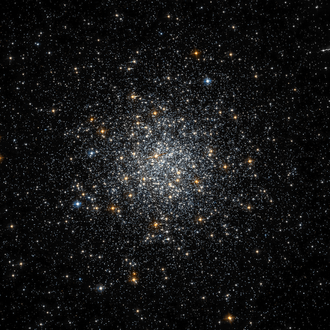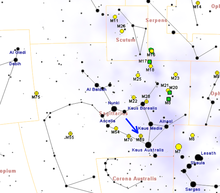Messier 69
|
Globular cluster Messier 69 |
|
|---|---|

|
|
| Photo from the Hubble Space Telescope | |
| AladinLite | |
| Constellation | Sagittarius |
|
Position equinox : J2000.0 , epoch : J2000.0 |
|
| Right ascension | 18 h 31 m 23.23 s |
| declination | −32 ° 20 ′ 52.7 ″ |
| Appearance | |
| Concentration class | V |
| Brightness (visual) | 8.31 mag |
| Brightness (B-band) | 9.32 likes |
| Angular expansion | 7.1 ' |
| Physical data | |
| Integrated spectral type | G2 / G3 |
| Redshift | (130 ± 16) · 10 −6 |
| Radial velocity | 39.1 ± 4.7 km / s |
| distance | 29.7 kLj (9.1 kpc ) |
| diameter | 85 ly |
| history | |
| discovery | Charles Messier |
| Discovery date | August 31, 1780 |
| Catalog names | |
| M 69 • NGC 6637 • C 1828-323 • GCl 96 • | |
Messier 69 (also known as NGC 6637) is a +8.31 mag bright globular cluster with an area of 7.1 'in the constellation Sagittarius .
The globular cluster was discovered by Charles Messier on August 31, 1780 when he was looking for an object described by Nicolas-Louis de Lacaille . M 69 is not easy to observe in Central Europe because of its southern position.
Investigations of the metallicity of Messier 69 and NGC 6624 suggest that the two globular clusters are 14 billion years old. Both likely belong to the galactic bulge .
Web links
swell
- ↑ a b c d e SIMBAD
- ^ NED data for the Messier Objects
- ↑ https://cseligman.com/text/atlas/ngc66.htm#6637
- ↑ JN Heasley, KA Janes, Robert Zinn, et al .: Hubble Space Telescope Photometry of the Metal-rich Globular Clusters NGC 6624 and NGC 6637. In: The Astronomical Journal 120 (2000), pp. 879-893, doi : 10.1086 / 301461


